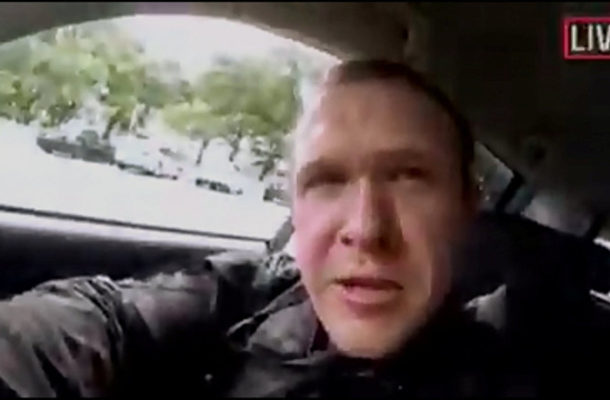The names of bygone noblemen and battles are written in different languages and indicate that the Christchurch gunman had an admiration for historic figures - in particular, Balkan military leaders - who fought against Muslim invaders in the past.
The gunman who killed 49 worshippers at two mosques in New Zealand's Christchurch posted images of his weapons before the shooting, which provides some insight into his ideology and beliefs.
He shared the photos of his automatic rifle, magazines and petrol containers on his Twitter account, which has already been taken down along with other traces of his social media presence. The images have still made their way into public.
— Reconnaissance Division (@ReconDivision) 15 марта 2019 г.
Scrawled on the Rifle
- 'Here's Your Migration Compact!' refers to the much-criticised non-binding UN agreement that seeks to establish a common global approach to international migration.
- John Hunyadi was a Hungarian military leader who ruled the country between 1446 and 1456 and led the national struggle against the Turks.
- '14 Words' (the number is repainted in several places on the ammo) is a nod to the 14-word white supremacist slogan derived from Adolf Hitler's Mein Kampf: "We must secure the existence of our people and a future for white children".
- 'Tours 732' refers to the Battle of Tours in 732. Frankish military leader Charles Martel pushed back the last Arab invasion of Western Europe.
- 'Turkofagos' ('Turk-eater' in Greek) was the nickname of Nikitas Stamatelopoulos, one of the main heroes of the Greek War of Independence waged by revolutionaries against the Ottomans between 1821 and 1829.
- On the other side of the stock, there's also a marking reading 'Anton Lundin Pettersson' — the attacker who fatally stabbed a teaching assistant and a student and wounded two other people in what police described as a racially charged incident. He later succumbed to the gunshot wounds he received during his apprehension.
- 'Marco Antonio Bragadin', also written on the other side, refers to a Venetian commander who led the resistance to the Ottoman conquest in 1570 and was eventually killed by the Turks.
- Josur Estrbanez was a then-22-year-old Spanish neo-Nazi who fatally stabbed 16-year-old anti-fascist protester in 2007. He was sentenced to 26 years in prison two years later.
- Milos Obilic was a semi-legendary knight who is said to have killed Ottoman sultan Murad I in the Battle of Kosovo in 1389. He is venerated as a saint in the Serbian Church.
- Sigismund of Luxembourg was a European noble who ruled the Holy Roman Empire in 1433-1437. He led the Crusade of Nicopolis, the last major crusade of the Middle Ages, which failed to liberate Bulgaria from the Ottoman rule in 1396.
- Feliks Kazimierz Potocki was a Polish commander, known as one of the country's richest noblemen of his time, who fought with the Ottomans and Tatars in the second half of the 17th century.
- Iosif Gurko was a Russian marshal credited with a series of victories in the Russo-Ottoman War of 1877-1878.
- 'Vienna 1683' refers to the Battle of Vienna which is considered to be a watershed moment in the Holy Roman Empire's centuries-long struggle with the Ottomans. After losing this battle, the Ottoman Empire no longer posed a threat to Christian Europe until its collapse in WW1.
- 'Acre 1189' is a reference to two the sieges of Acre, an ancient city today located in Israel. The first siege lasted from 1189 until 1191, and saw the king of the crusader-controlled Jerusalem repel Ottoman ruler Saladin.
- "For Rotherdam" refers to the child sexual exploitation scandal in the UK, wherein a British-Pakistani gang was convicted of sexually abusing at least 1,400 children between 1997 and 2013.
- Alexandre Bissonnette was the gunman who received a life sentence for killing six people at a Quebec mosque in January 2017.
- Luca Traini is an Italian neo-Nazi sympathizer who injured six African migrants in a shooting rampage in February 2017 and was sentenced to 12 years in prison.
- The Battle of Kagul of 1770 (written in Russian) was the key battle of the Russian-Ottoman War of 1768-1774, which saw Russian troops achieve a decisive victory over overwhelming Turkish forces.
- Bajo Pivljanin is a popular figure in Serbian epic poetry. He was a Serb commander who fought against the Ottomans in the second half of the 17th century.
- Fruzhin was a Bulgarian prince who headed an uprising against Ottoman ru;le in the early 15th century.
- The Battle of Bulair of 1913 was part of the First Balkan War; it saw Bulgarians defeat an Ottoman infantry division.
- Sebastiano Venier was a 16th-century Venetian ruler who headed the city's fleet in the Fourth Ottoman-Venetian War. He is perhaps best known as the admiral at the Battle of Lepanto of 1571, which saw the fleet of the so-called Holy League (an alliance of Christian states) deliver a stunning defeat to the Ottoman Empire off the Greek coast.
- Shipka Pass was a strategic path through the Balkan Mountains; joint Russian-Bulgarian forces successfully repulsed a series of attacks by the Ottoman army in 1877-1888, during the war which eventually led to the liberation of Bulgaria from the Ottoman Empire.
- Novak Vujošević was the hero of the Battle of Fundina against the Ottoman Empire's forces, who is believed to have killed 28 enemy soldiers.
He called this situation an "invasion" and accused European politicians, singling out Angela Merkel, of "racially cleansing" Europe. His attacks on the mosques drew condemnation from New Zealand officials, with the prime minister describing them as "an extraordinary and unprecedented act of violence." READ MORE: What is Known So Far About the Shooter Who Attacked Two New Zealand MosquesSource: sputniknews.com


Comments